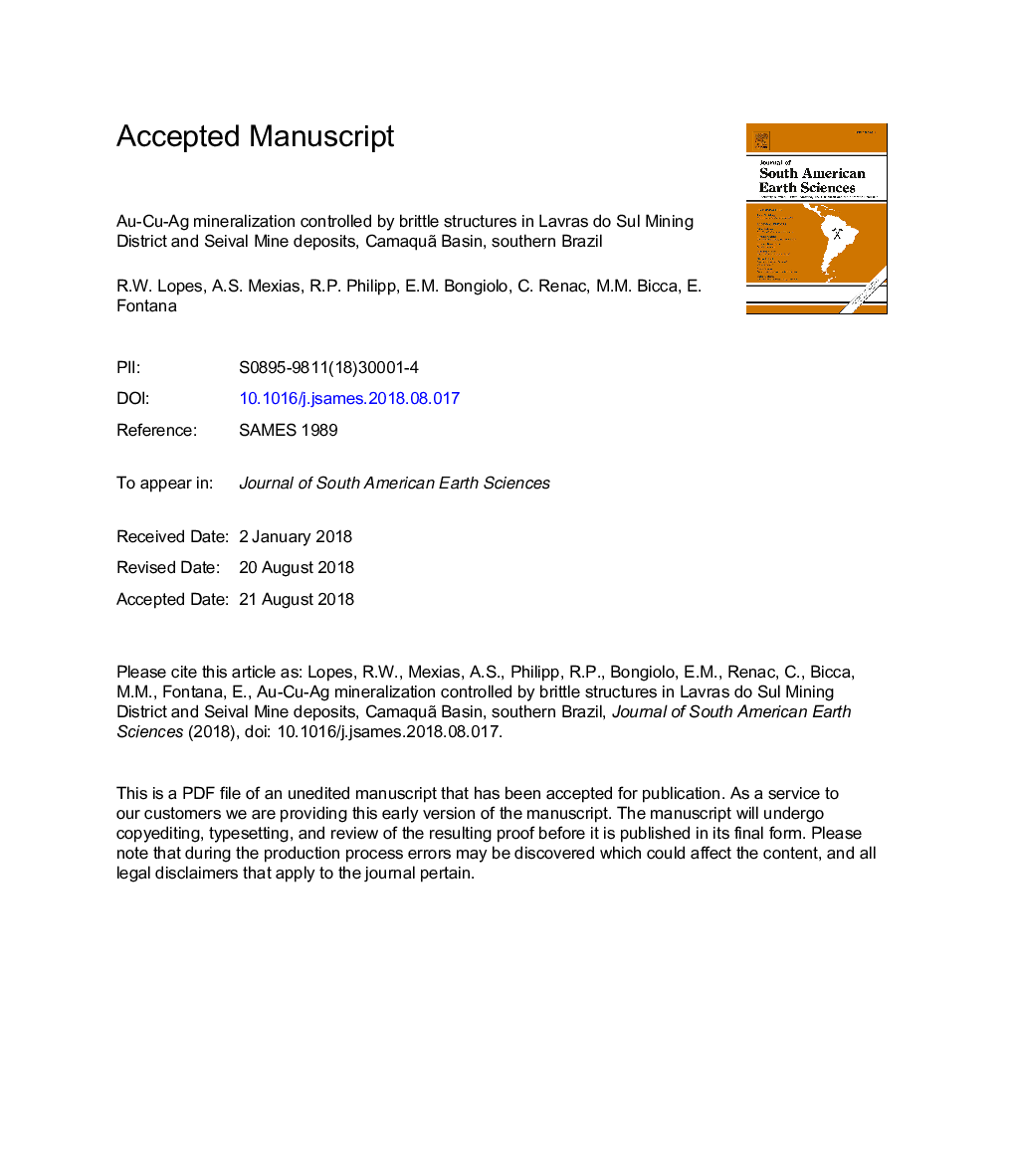| کد مقاله | کد نشریه | سال انتشار | مقاله انگلیسی | نسخه تمام متن |
|---|---|---|---|---|
| 10119912 | 1635123 | 2018 | 50 صفحه PDF | دانلود رایگان |
عنوان انگلیسی مقاله ISI
AuCuAg mineralization controlled by brittle structures in Lavras do Sul Mining District and Seival Mine deposits, Camaquã Basin, southern Brazil
دانلود مقاله + سفارش ترجمه
دانلود مقاله ISI انگلیسی
رایگان برای ایرانیان
کلمات کلیدی
موضوعات مرتبط
مهندسی و علوم پایه
علوم زمین و سیارات
علوم زمین و سیاره ای (عمومی)
پیش نمایش صفحه اول مقاله

چکیده انگلیسی
The mineralization of the Lavras do Sul Mining District and Seival Mine are controlled by brittle structures associated with the emplacement of the volcanogenic rocks and granitoids located in Lavras do Sul region, southernmost Brazil. This magmatism is associated with the evolution of the Camaquã Basin, an Ediacaran basin generated during the post-collisional stage of development of the Dom Feliciano Belt. The regional tectonic process has led to the activation of a large-scale high-angle shear zones and intense fracturing in the brittle to brittle-ductile regime. The relative chronology of structures and stress-field variations were recognized through remote sensing and structural data. The ore-deposits are controlled by extensional fractures and normal fault systems with a N70°W/70-85°NE direction in Lavras do Sul and a N40-60°E/70-88°NW direction in Seival and are disseminated or occur associated with quartz and calcite veins, respectively. We made a comparison of structures going from regional scale to smaller mineralized areas. The structural analysis of remote sensing and geophysical images (aeromagnetometry and aerogamma-spectrometry) integrated with structural data allowed us to reconstruct the paleostress tensor that generated the main fault systems and associated fractures of the host rock, which enabled the hydrothermal fluid circulation and the ore deposition. The integration of structural data such as fault slip planes, slickenlines, shear fractures systems, extensional fractures and kinematic indicators with the stratigraphic data allowed us to reconstruct the main directions of the tectonic efforts associated with the emplacement of the mineralizing magmas. The mineralization is associated with the sinistral N70°W/80-88°NE oriented Palma-Jacques Fault in the Lavras do Sul Mining District as well as the sinistral N50°E/80-88°SE oriented Cabritos-Perau Fault and the sinistral N20°E/80-88°SW oriented Segredo Fault in Seival Mine region. Their maximum compressional stresses are subhorizontal and NW-SE oriented, while a late subhorizontal and NE-SW oriented compressional stress affected only the rocks of the Seival Mine. These two main compressive stresses are associated with the development of a transcurrent (escape) tectonics during the final evolution of the Dom Feliciano Belt, constrained by UPb zircon geochronology between 600 and 580 Ma. Transcurrent and normal NE-SW oriented faults are more expressive in volcanogenic rocks of the Seival Mine area, while extensional vein-type NW-SE oriented fractures are the most important structures in the Lavras do Sul area. We suggested that N70°W/70-88°NE oriented monzonitic dikes in Lavras do Sul and N50°E/70-88°NW oriented andesitic to trachyandesitic dikes in Seival area are probably the source of the mineralization.
ناشر
Database: Elsevier - ScienceDirect (ساینس دایرکت)
Journal: Journal of South American Earth Sciences - Volume 88, December 2018, Pages 197-215
Journal: Journal of South American Earth Sciences - Volume 88, December 2018, Pages 197-215
نویسندگان
R.W. Lopes, A.S. Mexias, R.P. Philipp, E.M. Bongiolo, C. Renac, M.M. Bicca, E. Fontana,